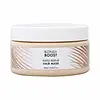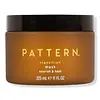What's inside
What's inside
 Key Ingredients
Key Ingredients

 Benefits
Benefits

 Concerns
Concerns

 Ingredients Side-by-side
Ingredients Side-by-side

Aloe Barbadensis Leaf Juice
Skin ConditioningCetearyl Alcohol
EmollientBehentrimonium Chloride
PreservativeGlycerin
HumectantCoco-Caprylate
EmollientPolyquaternium-10
Butyrospermum Parkii Butter
Skin ConditioningPropanediol
SolventHydroxypropyl Guar Hydroxypropyltrimonium Chloride
Argania Spinosa Kernel Oil
EmollientPanthenol
Skin ConditioningHydrolyzed Quinoa
Skin ConditioningOlea Europaea Fruit Oil
MaskingPrunus Amygdalus Dulcis Oil
Skin ConditioningVitis Vinifera Seed Oil
EmollientCaprylic/Capric Triglyceride
MaskingMacadamia Ternifolia Seed Oil
EmollientLavandula Angustifolia Flower Oil
MaskingEquisetum Arvense Leaf Extract
AstringentHydrolyzed Jojoba Esters
Skin ConditioningTerminalia Ferdinandiana Fruit Extract
AntioxidantLycium Barbarum Fruit Extract
AstringentCoffea Robusta Seed Extract
Skin ConditioningRosmarinus Officinalis Leaf Extract
AntimicrobialCucumis Sativus Fruit Extract
EmollientHydrolyzed Brazil Nut Protein
Skin ConditioningParfum
MaskingPentylene Glycol
Skin ConditioningCaprylyl Glycol
EmollientEthylhexylglycerin
Skin ConditioningCitric Acid
BufferingAloe Barbadensis Leaf Juice, Cetearyl Alcohol, Behentrimonium Chloride, Glycerin, Coco-Caprylate, Polyquaternium-10, Butyrospermum Parkii Butter, Propanediol, Hydroxypropyl Guar Hydroxypropyltrimonium Chloride, Argania Spinosa Kernel Oil, Panthenol, Hydrolyzed Quinoa, Olea Europaea Fruit Oil, Prunus Amygdalus Dulcis Oil, Vitis Vinifera Seed Oil, Caprylic/Capric Triglyceride, Macadamia Ternifolia Seed Oil, Lavandula Angustifolia Flower Oil, Equisetum Arvense Leaf Extract, Hydrolyzed Jojoba Esters, Terminalia Ferdinandiana Fruit Extract, Lycium Barbarum Fruit Extract, Coffea Robusta Seed Extract, Rosmarinus Officinalis Leaf Extract, Cucumis Sativus Fruit Extract, Hydrolyzed Brazil Nut Protein, Parfum, Pentylene Glycol, Caprylyl Glycol, Ethylhexylglycerin, Citric Acid
Water
Skin ConditioningGlycerin
HumectantPEG-40 Hydrogenated Castor Oil
EmulsifyingHydroxypropyl Starch Phosphate
Camellia Sinensis Leaf Extract
AntimicrobialHoney
HumectantHydroxyethylcellulose
Emulsion StabilisingCitric Acid
BufferingSodium Chloride
MaskingSodium Hydroxide
BufferingSodium Acetate
BufferingPropylene Glycol
HumectantPolyquaternium-37
Guar Hydroxypropyltrimonium Chloride
Skin ConditioningCetrimonium Chloride
AntimicrobialCellulose
AbsorbentPotassium Sorbate
PreservativePhenoxyethanol
PreservativeParfum
MaskingIsopropyl Alcohol
SolventLimonene
PerfumingGeraniol
PerfumingLinalool
PerfumingCitronellol
PerfumingCI 15985
Cosmetic ColorantCI 42090
Cosmetic ColorantWater, Glycerin, PEG-40 Hydrogenated Castor Oil, Hydroxypropyl Starch Phosphate, Camellia Sinensis Leaf Extract, Honey, Hydroxyethylcellulose, Citric Acid, Sodium Chloride, Sodium Hydroxide, Sodium Acetate, Propylene Glycol, Polyquaternium-37, Guar Hydroxypropyltrimonium Chloride, Cetrimonium Chloride, Cellulose, Potassium Sorbate, Phenoxyethanol, Parfum, Isopropyl Alcohol, Limonene, Geraniol, Linalool, Citronellol, CI 15985, CI 42090
Ingredients Explained
These ingredients are found in both products.
Ingredients higher up in an ingredient list are typically present in a larger amount.
Citric Acid is an alpha hydroxy acid (AHA) naturally found in citrus fruits like oranges, lemons, and limes.
Like other AHAs, citric acid can exfoliate skin by breaking down the bonds that hold dead skin cells together. This helps reveal smoother and brighter skin underneath.
However, this exfoliating effect only happens at high concentrations (20%) which can be hard to find in cosmetic products.
Due to this, citric acid is usually included in small amounts as a pH adjuster. This helps keep products slightly more acidic and compatible with skin's natural pH.
In skincare formulas, citric acid can:
While it can provide some skin benefits, research shows lactic acid and glycolic acid are generally more effective and less irritating exfoliants.
Most citric acid used in skincare today is made by fermenting sugars (usually from molasses). This synthetic version is identical to the natural citrus form but easier to stabilize and use in formulations.
Read more about some other popular AHA's here:
Learn more about Citric AcidGlycerin is already naturally found in your skin. It helps moisturize and protect your skin.
A study from 2016 found glycerin to be more effective as a humectant than AHAs and hyaluronic acid.
As a humectant, it helps the skin stay hydrated by pulling moisture to your skin. The low molecular weight of glycerin allows it to pull moisture into the deeper layers of your skin.
Hydrated skin improves your skin barrier; Your skin barrier helps protect against irritants and bacteria.
Glycerin has also been found to have antimicrobial and antiviral properties. Due to these properties, glycerin is often used in wound and burn treatments.
In cosmetics, glycerin is usually derived from plants such as soybean or palm. However, it can also be sourced from animals, such as tallow or animal fat.
This ingredient is organic, colorless, odorless, and non-toxic.
Glycerin is the name for this ingredient in American English. British English uses Glycerol/Glycerine.
Learn more about GlycerinParfum is a catch-all term for an ingredient or more that is used to give a scent to products.
Also called "fragrance", this ingredient can be a blend of hundreds of chemicals or plant oils. This means every product with "fragrance" or "parfum" in the ingredients list is a different mixture.
For instance, Habanolide is a proprietary trade name for a specific aroma chemical. When used as a fragrance ingredient in cosmetics, most aroma chemicals fall under the broad labeling category of “FRAGRANCE” or “PARFUM” according to EU and US regulations.
The term 'parfum' or 'fragrance' is not regulated in many countries. In many cases, it is up to the brand to define this term.
For instance, many brands choose to label themselves as "fragrance-free" because they are not using synthetic fragrances. However, their products may still contain ingredients such as essential oils that are considered a fragrance by INCI standards.
One example is Calendula flower extract. Calendula is an essential oil that still imparts a scent or 'fragrance'.
Depending on the blend, the ingredients in the mixture can cause allergies and sensitivities on the skin. Some ingredients that are known EU allergens include linalool and citronellol.
Parfum can also be used to mask or cover an unpleasant scent.
The bottom line is: not all fragrances/parfum/ingredients are created equally. If you are worried about fragrances, we recommend taking a closer look at an ingredient. And of course, we always recommend speaking with a professional.
Learn more about Parfum